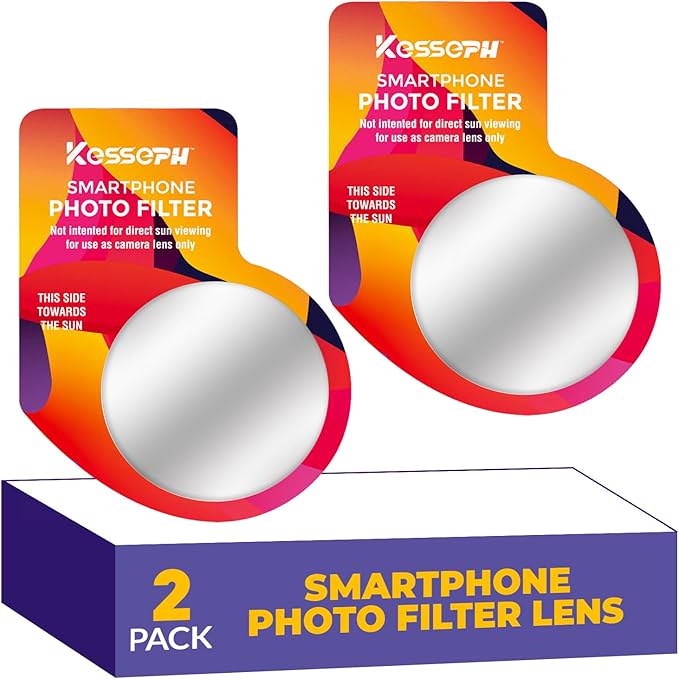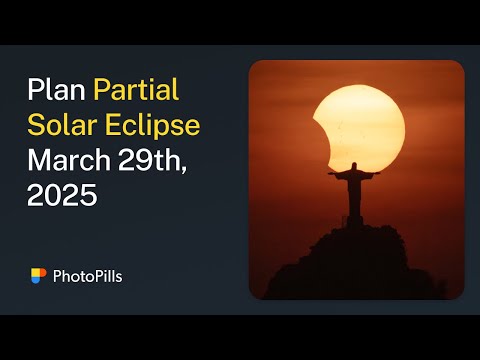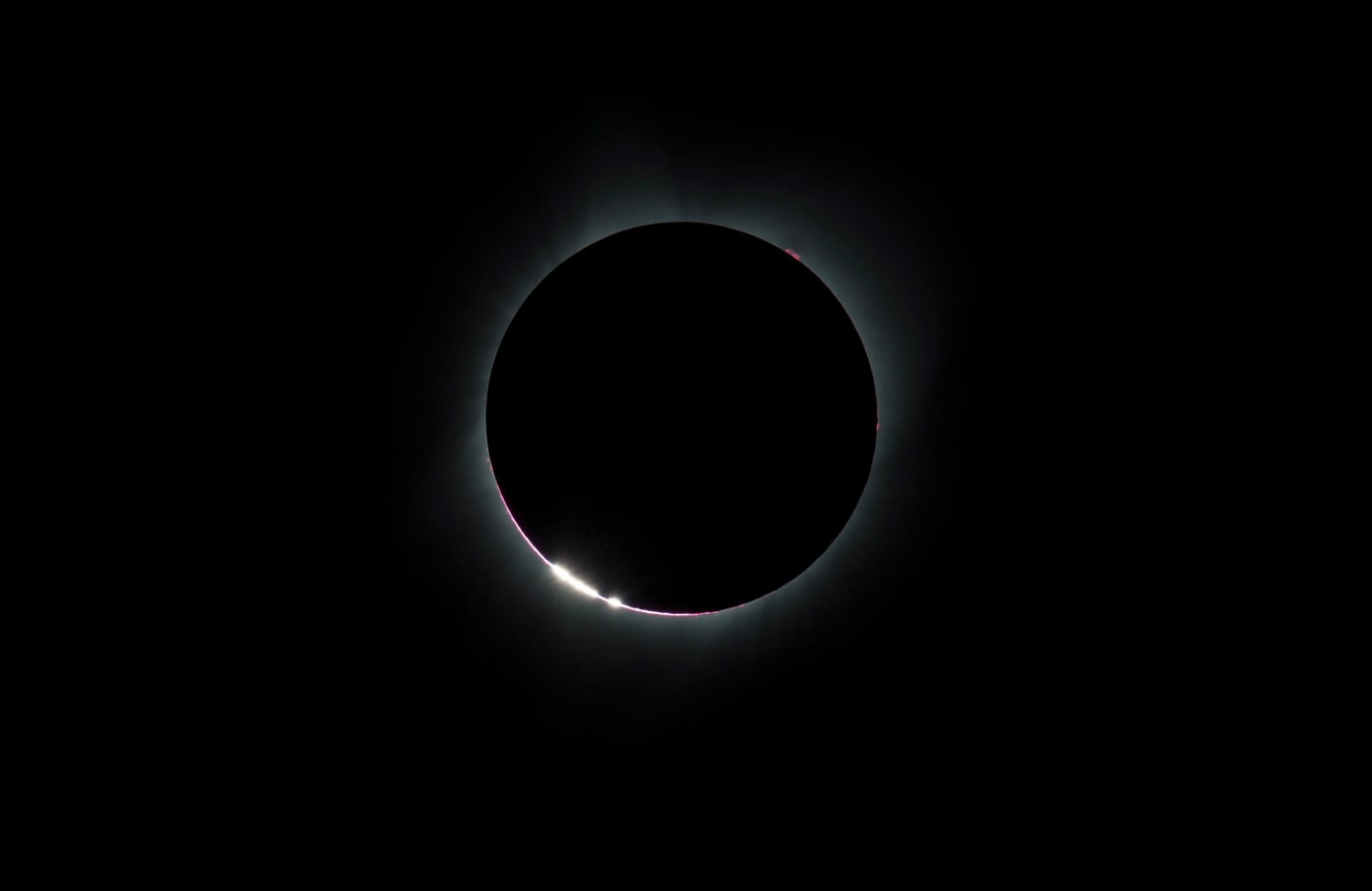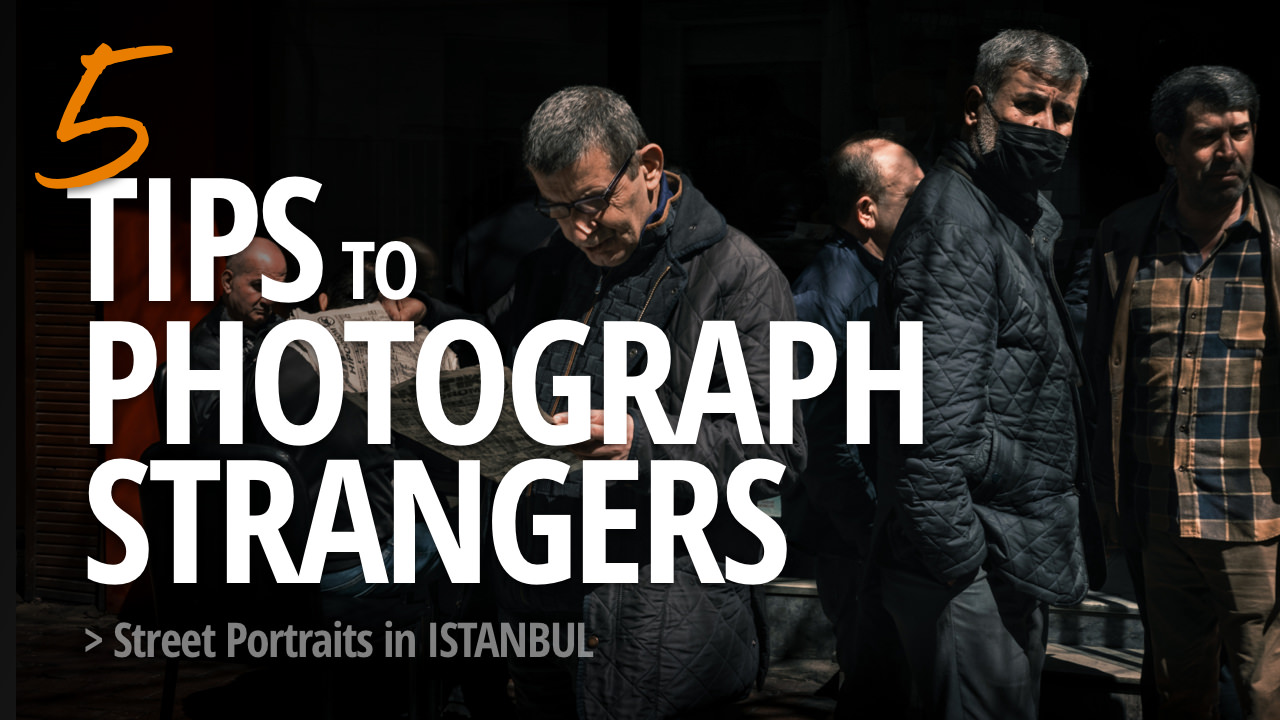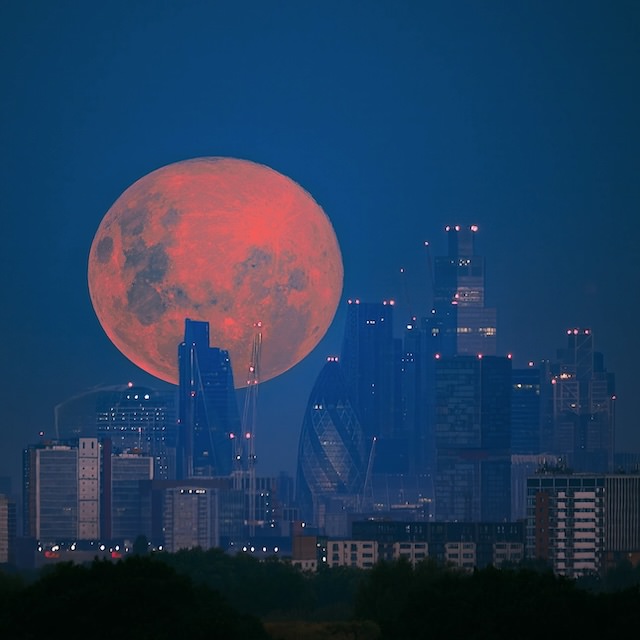No products in the cart.
In just a few days, on March 29th, 2025, sky watchers across the Northern Hemisphere will be treated to a spectacular celestial event – a partial solar eclipse. As the Moon glides between Earth and the Sun, it will create that characteristic “bite” on our star's disc, visible to millions across North America, Europe, Africa, and parts of Asia.
The memory of the full solar eclipse visible from the US only a few months ago is still very fresh. And rightly so. I can imagine many of you will feel the excitement for this new one, albeit partial (up to 94%).
Whether you're an experienced eclipse chaser or simply curious about witnessing this astronomical dance for the first time, this guide will walk you through everything you need to know about the upcoming partial solar eclipse – from understanding the science behind it to safely viewing and even photographing this celestial spectacle.
So mark your calendar, prepare your solar glasses, and let's dive into the fascinating world of partial solar eclipses!
Table of contents
- What is a Partial Solar Eclipse?
- The March 29 Partial Solar Eclipse: Essential Details
- Where to See the March 2025 Partial Solar Eclipse
- Viewing Safety: Protecting Your Eyes
- How to Photograph the Partial Solar Eclipse
- Planning Your Eclipse Day with PhotoPills
- The Science Behind Solar Eclipses
- Cultural and Historical Significance
- Looking Beyond: Future Eclipses After March 2025
- Conclusion
What is a Partial Solar Eclipse?
A partial solar eclipse occurs when the Moon passes between Earth and the Sun, but the three celestial bodies don't form a perfectly straight line. This alignment causes the Moon to cover only a portion of the Sun's disc from our perspective on Earth.
Unlike a total solar eclipse where the Sun is completely obscured, or an annular eclipse where a “ring of fire” appears around the Moon's silhouette, a partial eclipse creates what looks like a “bite” taken out of the Sun. The size of this bite varies depending on your viewing location – in some places, the Moon might cover just a sliver of the Sun, while in others, it could block out a significant portion.
During a partial solar eclipse, the Moon casts its weakest shadow, called the penumbra, onto Earth. This is different from a total eclipse, where the darkest part of the Moon's shadow, the umbra, creates the path of totality.
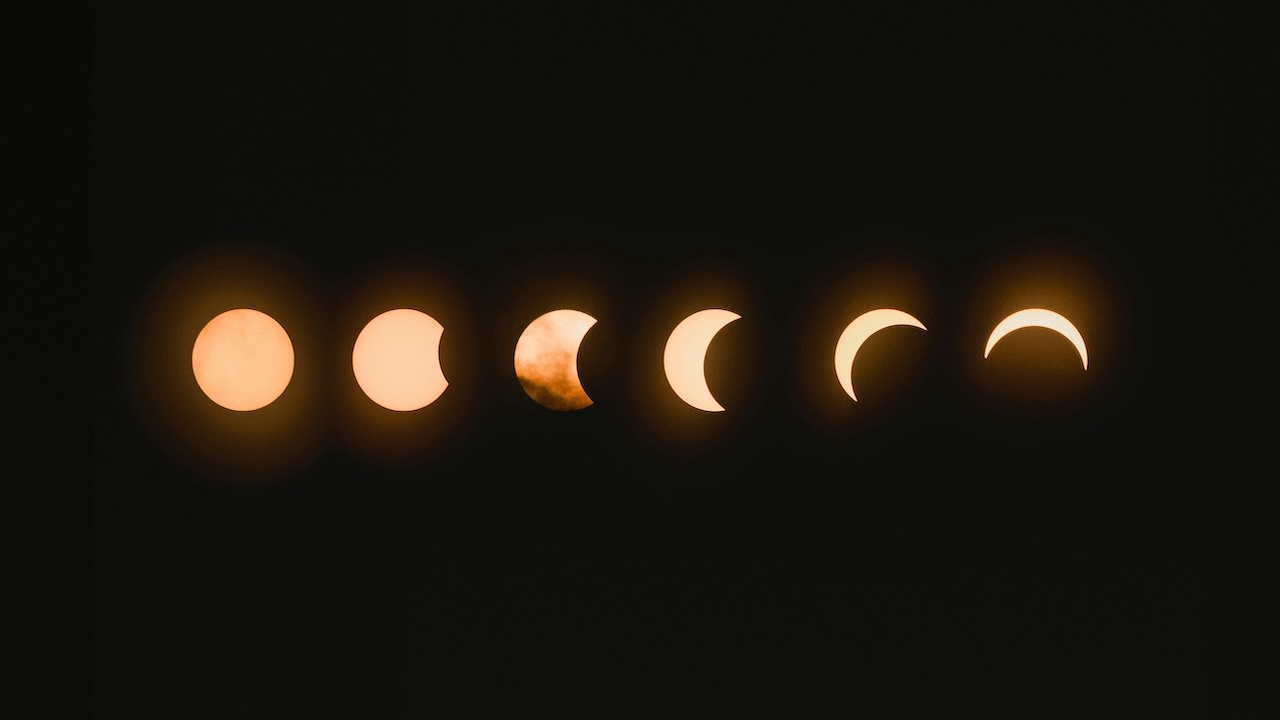

It's important to understand that even during a deep partial eclipse where most of the Sun is covered, the remaining crescent is still intensely bright and dangerous to view directly without proper eye protection. The Sun is never completely blocked during a partial eclipse, which means safe viewing practices are essential throughout the entire event.
The March 29 Partial Solar Eclipse: Essential Details
The upcoming partial solar eclipse on March 29th, 2025, promises to be a remarkable event visible across a wide swath of the Northern Hemisphere. Here are the essential details you need to know:
Date and Time
The eclipse will occur on Saturday, March 29th, 2025. The exact timing will vary based on your location, with viewers in different time zones experiencing the eclipse at different hours of the day:
- In North America, the eclipse will be visible primarily at sunrise in the eastern regions
- Across Europe, the eclipse will occur during mid-morning hours
- For viewers in parts of Africa and western Asia, the eclipse will happen around midday
Path and Magnitude
What makes this partial eclipse particularly noteworthy is its magnitude – up to 0.9376 at its maximum point. This means that at certain locations, especially in Iceland and parts of northern Europe, the Moon will cover nearly 94% of the Sun's disc, creating a dramatic crescent shape.
![Map showing the path of the March 29, 2025 partial solar eclipse] [Insert image suggestion here]
What Makes This Eclipse Special
The March 29th, 2025 eclipse stands out for several reasons:
- High magnitude: With up to 94% coverage in some areas, this will be one of the deepest partial eclipses in recent years.
- Wide visibility: The eclipse will be visible across multiple continents, making it accessible to hundreds of millions of people.
- Weekend timing: Occurring on a Saturday, many people will have the opportunity to view it without work or school commitments.
- Northern spring: The late March timing means relatively mild weather conditions for many viewers in the Northern Hemisphere.
As with any astronomical event, experiencing this eclipse will depend greatly on weather conditions. Clear skies are essential for viewing, so having contingency plans for different locations can be helpful.
Where to See the March 2025 Partial Solar Eclipse
The partial solar eclipse on March 29th, 2025, will be visible across a vast area of the Northern Hemisphere, but the percentage of the Sun that appears covered (the eclipse magnitude) will vary significantly depending on your location. Let's break down visibility by region:
Europe
Europe will enjoy some of the best views of this partial solar eclipse:
- Iceland: 85-94% coverage (among the highest anywhere in the world)
- United Kingdom: 50-70% coverage (higher in northern Scotland)
- Ireland: 60-70% coverage
- Scandinavia (Norway, Sweden, Finland): 60-85% coverage
- Central Europe (Germany, France, Spain, Italy): 40-60% coverage
- Eastern Europe (Poland, Ukraine, Romania): 50-65% coverage
For European viewers, the eclipse will occur during convenient mid-morning hours, making it highly accessible.
North America
In North America, the eclipse will be primarily visible from eastern Canada, particularly:
- Newfoundland and Labrador: 45-60% coverage
- Nova Scotia: 30-45% coverage
- Prince Edward Island: 35-45% coverage
- Eastern Quebec: 30-40% coverage
For most viewers in these regions, the eclipse will occur around sunrise, creating potential opportunities for dramatic photographs with the partially eclipsed Sun rising over the horizon. The rest of the United States and Canada will unfortunately miss this eclipse.
Africa
Northern parts of Africa will experience the eclipse:
- Morocco: 40-50% coverage
- Algeria: 35-50% coverage
- Tunisia: 40-55% coverage
- Libya: 40-60% coverage
- Egypt: 40-55% coverage
The eclipse will gradually diminish in magnitude as you move further south in Africa, eventually becoming invisible beyond central portions of the continent.
Asia
Western and northern portions of Asia will see the eclipse:
- Turkey: 50-65% coverage
- Western Russia: 60-80% coverage
- Kazakhstan: 50-65% coverage
- Western China: 20-40% coverage (in the extreme northwest only)
For many Asian viewers, the timing will be around midday.
The eclipse will NOT be visible from:
- Western and central parts of North America
- South America (except for small northern portions)
- Southern Africa
- Most of Asia
- Australia and Oceania
Best Viewing Locations
If you're planning to travel specifically to see this eclipse at its most impressive, consider these prime viewing locations:
- Iceland: With up to 94% coverage, especially in northern parts, Iceland offers the most dramatic views of this eclipse.
- Northern Scandinavia: Northern Norway, Sweden and Finland will see 80-85% coverage.
- Northern Scotland: The Shetland and Orkney Islands will experience around 80% coverage.
- Svalbard: This Norwegian archipelago in the Arctic Ocean will see up to 90% coverage.
- Faroe Islands: Located between Norway and Iceland, the Faroes will experience approximately 85% coverage.
Remember that while these locations offer the highest eclipse magnitudes, they also present challenges related to weather, accessibility, and potentially harsh conditions in March. Weather patterns should be carefully considered when planning travel.
Local Timing for Major Cities
Here are the approximate local times for the eclipse in selected major cities:
- London, UK: Begins 9:50 AM, maximum 10:55 AM (55% coverage), ends 12:05 PM – if you would like to join me, DM me on Instagram @fabienb
- Paris, France: Begins 10:00 AM, maximum 11:10 AM (50% coverage), ends 12:20 PM
- Berlin, Germany: Begins 10:10 AM, maximum 11:20 AM (60% coverage), ends 12:35 PM
- Madrid, Spain: Begins 9:40 AM, maximum 10:50 AM (45% coverage), ends 12:05 PM
- Rome, Italy: Begins 10:15 AM, maximum 11:30 AM (45% coverage), ends 12:45 PM
- Stockholm, Sweden: Begins 10:05 AM, maximum 11:25 AM (75% coverage), ends 12:50 PM
- Reykjavik, Iceland: Begins 9:15 AM, maximum 10:40 AM (90% coverage), ends 12:10 PM
- St. John's, Canada: Begins 6:05 AM, maximum 7:15 AM (45% coverage), ends 8:35 AM
(Note: Times are approximate and should be verified closer to the eclipse date)
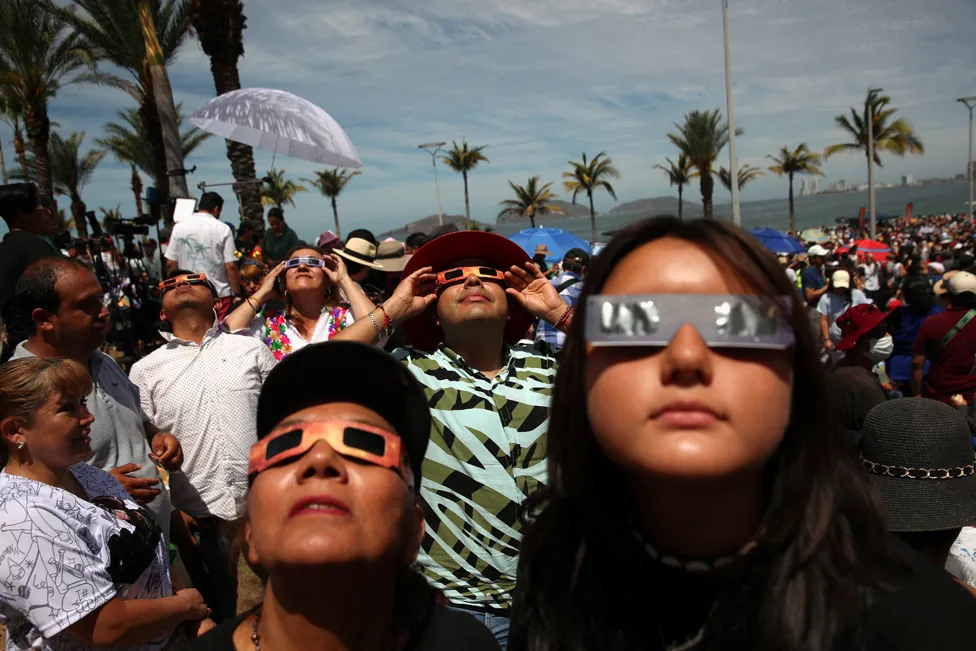

Viewing Safety: Protecting Your Eyes
When it comes to solar eclipses of any kind – partial, annular, or total – safety must be your top priority. Even during a deep partial eclipse where the Moon covers a significant portion of the Sun, the remaining crescent is intensely bright and emits harmful radiation that can cause permanent eye damage or blindness within seconds.
Why Direct Viewing Is Dangerous
The danger comes from several factors:
- Concentrated Solar Radiation: Your pupils dilate when looking at the darkened portion of the eclipsed Sun, allowing more harmful rays to enter your eyes.
- Absence of Pain Receptors: Your retina lacks pain receptors, so damage occurs without you feeling any discomfort until it's too late.
- Cumulative Effect: Eye damage can accumulate without immediate symptoms, leading to permanent vision problems later.
Never look directly at a partial solar eclipse without proper protective equipment – not even for a few seconds.
Safe Viewing Methods
There are several approved methods for safely viewing a partial solar eclipse:
Certified Solar Viewing Glasses
Solar eclipse glasses must meet the international safety standard ISO 12312-2:
- Look for this certification printed on the glasses
- Purchase from reputable vendors (astronomical societies often provide recommendations)
- Ensure they're not scratched, punctured, or damaged in any way
- Put them on before looking toward the Sun, and turn away before removing them
Solar viewing glasses are inexpensive but extremely effective, blocking 99.999% of the Sun's harmful radiation. They make the Sun appear comfortably dim, similar to a full moon at night.
Pinhole Projectors
A simple, free alternative that involves projecting the Sun's image rather than looking directly at it:
- Take two pieces of stiff card
- Make a small, clean pinhole in one card
- With your back to the Sun, hold the pinhole card so sunlight passes through the hole
- Project the resulting image onto the second card
- The farther apart you hold the cards, the larger (but dimmer) the projected image will be
You can create more elaborate pinhole projectors using boxes for better contrast and easier viewing.
Telescope or Binocular Projection
If you have optical equipment but no solar filter:
- Never look through an unfiltered telescope or binoculars at the Sun
- Instead, use them to project the Sun's image onto a white card
- For telescopes, use the finder scope to cast the shadow of the telescope on the ground, helping you aim without looking at the Sun
- Once aligned, place a white card 20-30cm behind the eyepiece to catch the projected image
What NOT to Use
These methods do NOT provide adequate protection and should never be used:
- Regular sunglasses (even multiple pairs or very dark ones)
- Smoked glass
- Exposed film negatives
- CDs/DVDs
- Food wrappers
- Household filters
- Taking quick glances with naked eyes
Special Considerations for Children
Children need extra supervision during eclipse viewing:
- Explain the dangers clearly but without causing unnecessary fear
- Help them put on and remove viewing glasses correctly
- Consider using only projection methods for very young children
- Make it a supervised activity, never leaving children alone with viewing equipment
- Practice using the glasses or projectors beforehand so they're comfortable with the process
Remember: A partial solar eclipse, no matter how deep, requires proper eye protection throughout the entire event. There is no safe period for direct viewing without protection.


How to Photograph the Partial Solar Eclipse
Capturing the March 2025 partial solar eclipse can result in stunning images that you'll treasure for years to come. However, just as with viewing the eclipse, photography requires proper equipment and techniques to protect both your eyes and your camera gear. Here's a comprehensive guide to photographing this celestial event:
Essential Equipment
Camera Recommendations
You don't need professional-grade equipment to photograph the eclipse, but certain features will help:
- DSLR or Mirrorless Camera: These offer the greatest control and image quality
- Bridge Cameras or Superzooms: Good alternatives with built-in telephoto capabilities
- Smartphones: Can capture basic eclipse images, especially with additional accessories
The most important factor is having sufficient zoom capability. The Sun appears approximately 0.5 degrees wide in the sky, so without zoom, it will appear as a tiny dot in your frame.
Required Solar Filters
This is non-negotiable – you must use proper solar filters to photograph the eclipse:
- Dedicated Solar Photography Filters: These metal-coated glass or polymer film filters attach to the front of your lens
- Solar Filter Strength: Look for filters rated at 5.0 ND (16.5 stops) or stronger
- Full Aperture Filters: These cover the entire front element of your lens, not just the eyepiece
Important: Never use eyepiece filters alone for photography, as concentrated sunlight can crack them and damage your eye. The filter must go on the front of the lens before the light enters the camera.
Tripods and Mounts
Due to the long focal lengths needed and potentially slower shutter speeds:
- Sturdy Tripod: Essential for sharp images, especially at high magnification
- Remote Shutter Release: Helps prevent camera shake
- Tracking Mount (optional): For advanced photographers, a motorized mount that follows the Sun's movement allows for longer exposures and video
Camera Settings for Best Results
ISO Settings
- Start with ISO 100 or 200 for the cleanest image quality
- Despite using solar filters, there's plenty of light, so low ISO values work well
- Increase only if you need faster shutter speeds due to wind or equipment limitations
Aperture Recommendations
- Use middle apertures (f/8 to f/11) for optimal lens sharpness
- Avoid extremely narrow apertures (f/22+) where diffraction can reduce image quality
- With proper solar filters, light management isn't an issue – focus on optical quality
Shutter Speed Guidance
- Start with 1/125 to 1/500 second with proper solar filters
- Take test shots and adjust as needed – your histogram should show good exposure without clipping
- Consider bracketing exposures (taking multiple shots at different settings) to ensure you capture details in both the Sun's surface and the leading edge of the Moon
Focus Tips
- Autofocus may struggle with the filtered Sun – switch to manual focus
- Use your camera's live view with maximum magnification to achieve precise focus
- Focus on the edge of the Sun's disc for maximum sharpness
- Set focus before the eclipse begins and then switch to manual to lock it in
Tips for Smartphone Photography
Modern smartphones can capture decent eclipse images with some adaptations:
- Dedicated Solar Filters: Just like larger cameras, smartphones need proper solar filters
- Avoid Digital Zoom: It reduces image quality; instead, use optical zoom if your phone has it
- Stabilization: Use a small tripod or phone mount – even a bean bag can help
- Pro Mode: Use your phone's manual mode if available for better control
- Apps: Consider specialized astronomy photography apps that offer better control
- Telephoto Lens Attachments: These clip-on accessories can significantly improve results
Processing Your Eclipse Images
After the eclipse, enhance your photos with these processing tips:
- Contrast Adjustments: Bring out the detail in the Sun's surface features
- Sharpening: Apply careful sharpening to enhance the crisp edge of the Moon against the Sun
- Composites: Consider creating a composite showing the progression of the eclipse
- Colour Balance: The Sun may appear slightly yellow-orange through filters – you can adjust this to your preference
- Detail Enhancement: Techniques like deconvolution can reveal subtle solar features
Remember that safety comes first – never compromise eye or equipment safety for a photograph. With proper planning and equipment, you can safely capture this remarkable celestial event.
Planning Your Eclipse Day with PhotoPills
Planning is essential for successfully viewing and photographing the March 29th, 2025 partial solar eclipse. One of the most powerful tools available for this purpose is PhotoPills, a comprehensive photography planning app that offers specific features for eclipse preparation. This is the app I use for all my plans.
Using PhotoPills for Eclipse Planning
PhotoPills offers several specific features that make eclipse planning straightforward:
Finding Where and When the Eclipse is Visible
- In the app, tap on the map settings button
- Navigate to the eclipse layer options
- Switch on the eclipse information on the map and top panels
- Access the eclipse calendar and select the March 29th, 2025 partial solar eclipse
- The map will display yellow and orange lines indicating where the eclipse will be visible
- Areas between these lines will experience the eclipse
- Areas outside these boundaries won't see the eclipse
Understanding Eclipse Magnitude by Location
The app visually represents how much of the Sun will be covered at different locations:
- Position the red pin at your intended viewing location
- Swipe the top panel left until you reach the eclipse panel
- Here you'll see the local times for each phase of the eclipse (beginning, maximum, end)
- The panel also displays a visual representation of how the Sun will appear during maximum eclipse at your location
- You can adjust the time slider to see how the eclipse progresses throughout the event
For example, in Madrid, the eclipse will create a modest but visible “bite” on the Sun. As you move further north to places like Iceland, the bite becomes significantly larger, covering much more of the solar disc.
Augmented Reality Eclipse Visualization
One of PhotoPills' most impressive features is its ability to show you exactly where the eclipse will happen in your sky:
- Place the red pin at your planned viewing location
- Tap the AR (Augmented Reality) button
- The app will display the path of the Sun across your actual surroundings through your phone's camera
- You can see exactly where in the sky the eclipse will occur relative to your landscape
- This helps identify potential foreground elements for compelling compositions
- Use the visual calibration feature to ensure accurate alignment
For instance, in Madrid, the eclipse will occur high in the sky, making it challenging to include interesting foreground elements unless you have access to tall structures.
Weather Considerations and Backup Plans
While apps like PhotoPills can tell you exactly where and when the eclipse will occur, they can't guarantee clear skies:
- Check weather forecasts regularly in the week leading up to the eclipse
- Identify multiple potential viewing locations along the eclipse path
- Be prepared to travel on short notice if weather threatens your primary location
- Consider altitude – higher elevations often have clearer skies and less atmospheric distortion
- Research historical weather patterns for potential viewing locations to identify areas with statistically better chances of clear skies
Timing Your Observation
The partial solar eclipse will last approximately 2-3 hours from start to finish, with these distinct phases:
- First contact: When the Moon first begins to cover the Sun's disc
- Maximum eclipse: When the Moon covers the maximum portion of the Sun
- Last contact: When the Moon completely moves away from the Sun's disc
For the most complete experience, plan to be at your viewing location at least 30 minutes before first contact and stay until after last contact. This allows you to witness the entire progression of the event.
By using PhotoPills for detailed planning and preparing thoroughly for eclipse day, you'll maximize your chances of a successful and memorable eclipse viewing experience. Here is the video from their official channel explaining how to use the app for this specific event:


The Science Behind Solar Eclipses
To truly appreciate the partial solar eclipse on March 29th, 2025, it helps to understand the fascinating science behind these celestial events.
Orbital Mechanics: A Cosmic Dance
Solar eclipses occur due to a remarkable cosmic coincidence: the Sun is approximately 400 times larger than the Moon, but it's also roughly 400 times farther away from Earth. This makes the Sun and Moon appear almost exactly the same size in our sky—a coincidence not known to exist anywhere else in our solar system.
For a solar eclipse to happen, three celestial bodies—the Sun, Moon, and Earth—must align in a nearly straight line, with the Moon positioned between the Sun and Earth. This alignment is called syzygy (pronounced “SIZ-i-jee”), a term derived from Greek meaning “yoked together.”
However, several factors create the different types of solar eclipses we observe:
- The Moon's Elliptical Orbit: The Moon doesn't orbit Earth in a perfect circle but follows an elliptical path, meaning its distance from Earth varies. When a solar eclipse occurs with the Moon at or near perigee (its closest approach to Earth), the Moon appears large enough to cover the Sun completely, creating a total eclipse. When the Moon is farther away (near apogee), it appears smaller and creates an annular eclipse.
- Orbital Planes: The Moon's orbit is tilted about 5 degrees relative to Earth's orbit around the Sun (the ecliptic plane). This means that most new moons pass either above or below the Sun from our perspective, creating no eclipse at all.
- Partial Eclipse Mechanics: A partial solar eclipse, like the one occurring on March 29th, 2025, happens when the alignment of the Sun, Moon, and Earth is imperfect. From our perspective on Earth, the Moon appears to take a “bite” out of the Sun rather than covering it completely.
![Diagram illustrating the mechanics of different types of solar eclipses] [Insert image suggestion here]
How Eclipses Are Predicted
Modern eclipse predictions are incredibly precise, allowing astronomers to calculate the timing, duration, and visibility of eclipses thousands of years into the future or past. This precision relies on:
- Mathematical Models: Complex equations describe the orbits of Earth and the Moon around the Sun, accounting for gravitational influences from other planets and even the slight bulge of the Earth at the equator.
- Historical Records: Eclipse observations dating back thousands of years help refine these models. Ancient Babylonian, Chinese, and Greek records of eclipses have proven invaluable for this purpose.
- Computer Simulations: Modern computing power allows astronomers to simulate the positions of celestial bodies with extraordinary precision, calculating eclipse paths down to the kilometre and second.
The March 29th, 2025 partial eclipse has been predicted through these methods, with astronomers calculating exactly where the Moon's penumbral shadow will fall across Earth's surface.
Frequency of Solar Eclipses
Solar eclipses aren't as rare as many people believe:
- Global Frequency: Two to five solar eclipses occur somewhere on Earth every year.
- Local Rarity: From any specific location, seeing a solar eclipse is much rarer—a total solar eclipse occurs at the same spot on Earth only once every 375 years on average.
- Partial vs. Total: Partial solar eclipses are much more common than total eclipses because the Moon's penumbral shadow covers a much larger area of Earth than its umbral shadow.
For context, after the March 29th, 2025 partial eclipse, the next solar eclipse will be a partial one on September 21st, 2025. This means 2025 will feature two solar eclipses, which is fairly typical.
Common Misconceptions Clarified
Several misconceptions about solar eclipses persist:
- Eclipses and Vision: Looking at an eclipse doesn't damage your eyes because it's an eclipse – it's because looking at the Sun is always dangerous. The danger during eclipses comes from people being more tempted to look directly at the Sun.
- Eclipses and Pregnancy: There is no scientific evidence that eclipses have any physical effect on pregnant women or unborn children. These beliefs stem from cultural superstitions rather than scientific fact.
- Eclipse Frequency: Many people believe eclipses are extremely rare events. While total eclipses at a specific location are indeed rare, solar eclipses in general happen multiple times each year somewhere on Earth.
- Eclipse Prediction: Ancient civilizations viewing eclipses as unpredictable omens is another misconception. Many ancient cultures, including the Babylonians and Chinese, could predict eclipses with reasonable accuracy.
Understanding the science behind eclipses enhances our appreciation of these events, transforming them from mysterious occurrences into predictable, yet no less awe-inspiring, demonstrations of celestial mechanics.
Cultural and Historical Significance
Solar eclipses have fascinated humanity throughout history, inspiring awe, fear, myths, and scientific inquiry across civilisations. The March 2025 partial solar eclipse continues this rich tradition of human engagement with celestial phenomena.
How Different Cultures Have Interpreted Solar Eclipses
Throughout history, diverse cultures have developed fascinating explanations for solar eclipses:
- Ancient China: Eclipses were thought to be caused by a celestial dragon devouring the Sun. Court astronomers would bang drums and shoot arrows into the sky to frighten away the dragon. Interestingly, failure to predict eclipses could have deadly consequences—records show that two court astronomers, Hi and Ho, were executed around 2134 BCE for failing to predict an eclipse.
- Norse Mythology: The Vikings believed that a pair of wolves, Sköll and Hati, chased the Sun and Moon across the sky. When one caught the Sun, an eclipse occurred.
- Hindu Tradition: In Hindu mythology, the demon Rahu is beheaded by the god Vishnu after stealing an immortality elixir. His disembodied head occasionally swallows the Sun, causing eclipses, but since he has no body, the Sun reappears.
- Indigenous American Perspectives: Many Native American communities viewed eclipses as transformative events. The Chippewa would shoot flaming arrows toward the Sun to rekindle it during an eclipse. The Tewa people of New Mexico would stay silent and still during eclipses, believing that speaking could disrupt the celestial balance.
- West African Traditions: In parts of West Africa, eclipses represented celestial reconciliation—a moment when the Sun and Moon, often portrayed as quarrelling spouses in folklore, briefly resolved their differences.
Modern cultural responses to eclipses have evolved but remain significant. Many communities now hold eclipse festivals, viewing parties, and educational events that blend scientific understanding with cultural celebration.
Notable Historical Partial Eclipses
While total eclipses often receive more attention, significant partial eclipses have also made their mark on history:
- May 28, 585 BCE: A partial solar eclipse visible across Asia Minor reportedly halted a battle between the Lydians and the Medes. The Greek philosopher Thales of Miletus had predicted this eclipse, marking one of the first recorded scientific predictions of an astronomical event.
- August 2, 1133 CE: Known as “King Henry's Eclipse,” this partial eclipse occurred upon the death of King Henry I of England and was interpreted as a bad omen. It coincided with a period of civil war known as “The Anarchy.”
- May 12, 1706: During the War of Spanish Succession, a deep partial eclipse visible across Europe was used advantageously by the Duke of Marlborough to surprise French troops in an early morning attack.
- August 21, 1914: A partial eclipse visible across Eastern Europe coincided with the opening battles of World War I, reinforcing superstitious fears during an already turbulent time.
- January 4, 2011: A partial eclipse visible across Europe, North Africa, and Central Asia was the first of four partial solar eclipses that occurred in 2011, an unusually high number in a single year.
Scientific Discoveries Made During Eclipses
Solar eclipses have contributed significantly to scientific advancement:
- Helium Discovery: During the 1868 total eclipse in India, French astronomer Pierre Janssen observed a new spectral line in the Sun's chromosphere, leading to the discovery of helium—the first element discovered in space before being found on Earth.
- Einstein's Theory of Relativity: While this was confirmed during the 1919 total eclipse, partial eclipses have also provided valuable data for testing gravitational theories by measuring the bending of starlight near the Sun.
- Solar Corona Studies: Even during deep partial eclipses, astronomers have gained insights into the Sun's atmosphere structure, helping develop our understanding of solar physics.
- Historical Climate Records: Ancient eclipse records have helped scientists reconstruct Earth's rotational history, contributing to our understanding of climate patterns over millennia.
Eclipse Folklore and Myths
Fascinating folklore surrounds solar eclipses across cultures:
- Food and Water Taboos: In many traditional societies, food and water prepared during an eclipse were considered contaminated. In some parts of India, this belief persists today.
- Protection Rituals: Pregnant women in various cultures were advised to stay indoors during eclipses, wear red, or attach safety pins to their clothing for protection.
- Eclipse Whispers: A Japanese tradition holds that wishes whispered during an eclipse have special power, as the alignment of celestial bodies creates a unique channel for human desires.
- Noise Making: The tradition of making loud noises during eclipses—from drumming to firing cannons—spans cultures from ancient China to Indigenous American societies, all aimed at scaring away whatever was “eating” the Sun.
- Reconciliation Moments: Some cultures viewed eclipses as times when disputes should be resolved, believing that the celestial harmony created an auspicious moment for making peace.
While we now understand the scientific mechanisms behind eclipses, these cultural perspectives enrich our experience of these events, connecting us to how our ancestors interpreted the same cosmic dance we'll witness in March 2025.
Looking Beyond: Future Eclipses After March 2025
While the March 29th, 2025 partial solar eclipse will be a spectacular event, it's just one in an ongoing series of eclipses that astronomy enthusiasts can look forward to. Understanding the eclipse “calendar” helps put this event in context and plan for future celestial observations.
Next Notable Eclipses in 2025 and Beyond
The astronomical calendar offers several exciting eclipse events following the March 2025 partial solar eclipse:
Later in 2025
- September 7, 2025: A total lunar eclipse visible from the Americas, Europe, Africa, and western Asia. During this event, the Moon will pass through Earth's shadow, taking on a reddish hue often called a “blood moon.”
- September 21, 2025: Another partial solar eclipse, this one visible primarily from the southern hemisphere—particularly South Africa, Antarctica, and parts of the Indian Ocean region.
Key Solar Eclipses in 2026-2027
- August 12, 2026: A total solar eclipse crossing Greenland, Iceland, and Spain. This will be particularly significant for European observers who will have an opportunity to experience totality without extensive travel.
- February 6, 2027: An annular solar eclipse visible across South America, crossing Chile and Argentina before moving across the Atlantic to Africa.
- August 2, 2027: A remarkable total solar eclipse with the longest duration of totality this century (6 minutes and 23 seconds), crossing Spain, North Africa, and the Arabian Peninsula.
Notable Lunar Eclipses
- March 3, 2026: A total lunar eclipse visible from the Americas, Europe, Africa, and western Asia.
- August 28, 2026: A total lunar eclipse visible from East Asia, Australia, and western North America.
How the March 2025 Eclipse Compares to Upcoming Events
The March 29th, 2025 partial solar eclipse has some distinct characteristics compared to future eclipses:
- Accessibility: With visibility across Europe, parts of North America, and northern Africa, the March 2025 eclipse will be accessible to hundreds of millions of people without extensive travel—unlike some total eclipses that cross remote regions.
- Magnitude: At up to 94% in some regions, this partial eclipse will be deeper than many partial eclipses, creating noticeable darkening effects, especially in Iceland and northern Europe.
- Duration: Partial eclipses typically last longer overall than total eclipses. The March 2025 event will unfold over approximately 3 hours from start to finish at most locations, giving ample time for observation.
- Timing: Occurring in spring in the Northern Hemisphere, this eclipse benefits from potentially favourable weather conditions compared to winter eclipses.
However, it lacks the dramatic features of total eclipses like the August 2026 and August 2027 events, which will reveal the Sun's corona and bring brief darkness to the path of totality.
Conclusion
The partial solar eclipse on March 29th, 2025, offers a remarkable opportunity to connect with the cosmos and experience one of nature's most fascinating phenomena. Though it won't bring the dramatic darkness of a total eclipse, this event—with up to 94% of the Sun's disc covered in some locations—will create a noticeable and beautiful transformation of our daytime sky.
As we've explored throughout this guide, successful viewing of this eclipse demands proper preparation: understanding where and when it will be visible, ensuring you have appropriate safety equipment, planning photography if that interests you, and perhaps connecting with fellow enthusiasts or citizen science projects.
As you prepare for March 29th, 2025, remember that safety must come first. Proper eye protection is essential throughout the entire event, and sharing this knowledge—especially with children or first-time eclipse viewers—helps ensure everyone enjoys this celestial spectacle safely.
I hope this guide helps you make the most of this upcoming astronomical event. Mark your calendar, prepare your equipment, and keep an eye on the weather forecast as the day approaches. With proper planning, the partial solar eclipse of March 2025 could become one of your most memorable experiences with the night (or in this case, day) sky.
And if you're truly captivated by this event, remember that it's just one in an ongoing series of eclipses. Perhaps the March 2025 partial eclipse will be your gateway to eclipse chasing—a fascinating pursuit that can take you around the world following the celestial shadow dance of our Sun and Moon.
Whatever your approach, I wish you clear skies and a wonderful eclipse experience on March 29th, 2025!

